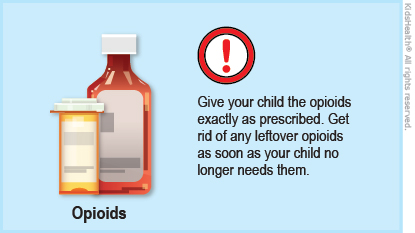Opioid Prescription Pain Medicines: How to Give Them to Your Child Safely
Kids sometimes need help controlling pain for a short period of time after surgery or a medical procedure. Often, an over-the-counter (OTC) pain medicine works well, but a prescription pain medicine might be needed for severe pain. Prescription pain medicines usually contain an opioid. Opioids work by blocking pain messages from reaching the brain.
When a health care provider prescribes opioids for pain, it's important to know how to use, store, and get rid of opioids safely.


Important Information About Opioid Medicines
-
Some opioid medicines contain acetaminophen (brand name Tylenol®) or ibuprofen (brand names Advil®, Motrin®). Check with your health care provider or pharmacist before giving your child acetaminophen or ibuprofen to make sure they don't get too much.
-
Don't give your child medicine that can cause drowsiness (for example, Valium®, Ativan®, or Xanax®) without checking with your health care provider or pharmacist. Taking these medicines with an opioid can be very dangerous.
-
Don't give your child any other medicines, herbs, or supplements without talking to your health care provider or pharmacist.
-
If your health care provider gave you a prescription for naloxone nasal spray (Narcan®), fill the prescription and be sure anyone who'll be caring for your child while they take opioids knows how to use it. Naloxone can reverse the effects of opioids and save someone's life if they take too much opioid medicine.
Dosing
-
You or another responsible adult should give the pain medicine exactly as you were instructed by the health care provider. Watch to see that your child swallows the medicine.
-
Make sure that your child is the only person who takes the medicine. Don't allow family, friends, or visitors to use your child's medicine.
-
Never tell kids that medicine "tastes like candy."
-
Don't allow your child to drink alcohol. This is especially dangerous while taking prescription pain medicines, and can lead to serious medical problems, even death.
-
Opioid pain medicine can make it hard to do some activities that call for being alert. Don't let your child ride a bike, swim, use a lawnmower, or drive while taking the medicine.
Storage
-
After giving your child a dose of the medicine, close the lid tightly and put it away in a locked cabinet, out of the reach of children, visitors, and pets. Don't leave it on a table or countertop.
-
Store the medicine in the container it came in.
-
Keep track of how much medicine is in the container.
Getting Rid of Unused Medicine

-
You have questions about when or how to give the opioid medicine or naloxone.
-
Your child has pain that interferes with eating, drinking, sleeping, and moving, even after they take the pain medicine.
-
Your child has side effects from the opioid medicine, such as:
-
constipation
-
sleepiness
-
itching
-
nausea or vomiting

Your child:
If your child has any of these symptoms and you have naloxone nasal spray, give it to them right away.

What opioid pain medicines are prescribed for kids and teens? Opioid pain medicines prescribed for kids and teens include:
-
hydrocodone with acetaminophen liquid (Hycet®) and pills (Vicodin® and Lortab®)
-
oxycodone with acetaminophen liquid (Roxicet®) and pills (Percocet® and Tylox®)
-
hydromorphone liquid and pills (Dilaudid®)
-
morphine liquid and pills
-
oxycodone liquid and pills
What else should I know about opioids? It's important to have conversations with your kids about using medicines safely. They should know that prescription pain medicines are only safe when prescribed by a health care provider and can be dangerous or addictive when misused. Health care providers carefully figure out the right dose of medicine for a patient. When the medicine is taken exactly as prescribed, it should reduce pain symptoms enough so that the child can eat, drink, sleep, move, and do other basic tasks. (It may not be possible to make the pain go away completely.) Taking too much medicine could be very dangerous. It can make someone breathe too slowly, which can lead to death.
Where can people get help for a substance abuse problem? Call SAMHSA's National Helpline at 800-662-HELP (4357). This free and confidential service is available in English and Spanish.